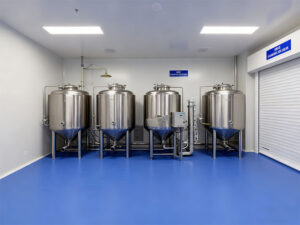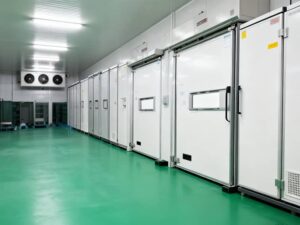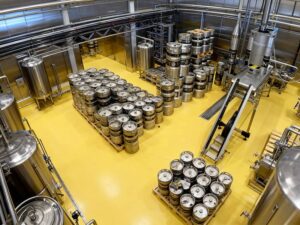The ideal flooring solution for an automotive service bay is a 100% solids polyurethane or polyaspartic coating system specifically formulated for hot tire pickup resistance and chemical resistance to automotive fluids. This system typically consists of a primer, a self-leveling or mortar base coat, and a durable top coat that can withstand thermal shock from hot tires while resisting gasoline, oil, and brake fluid degradation.
Automotive service bays require specialized flooring that outperforms standard residential garage coatings. The optimal solution must address three critical factors: resistance to hot tire pickup (the #1 cause of floor coating failure in auto shops), protection against petroleum-based chemicals, and durability under heavy equipment and constant traffic. This guide covers the complete specification process, from chemical composition and installation standards to maintenance protocols for commercial automotive facilities.
Why Standard Floor Coatings Fail in Automotive Service Bays
Most floor coating failures in automotive environments result from using residential-grade products not engineered for commercial demands. Standard epoxy coatings soften at temperatures as low as 140°F (60°C), while hot tires can reach 160°F+ (71°C+) upon arrival at service bays.
According to the American Society for Testing and Materials (ASTM), coatings for automotive service environments must meet specific standards:
- ASTM D1308: Resistance to household and commercial chemicals
- ASTM D2794: Resistance to organic solvents and fuels
- ASTM D969: Hot tire pickup resistance testing protocol
The thermal cycling from repeated hot tire contact causes standard coatings to soften, adhere to tires, and eventually delaminate from the concrete substrate. Simultaneously, constant exposure to motor oil, transmission fluid, brake fluid, and gasoline breaks down chemical bonds in inferior coatings.
Polyurethane vs. Epoxy: Performance in Automotive Environments
The debate between epoxy vs polyurethane garage floor coatings is settled in automotive applications. While epoxy provides excellent adhesion and chemical resistance, polyurethane surpasses it in thermal stability and flexibility.
Polyurethane vs. Epoxy Performance Comparison for Automotive Shops
| Performance Characteristic | طلاء البولي يوريثان | طلاء الإيبوكسي | Test Standard |
|---|---|---|---|
| Hot Tire Pickup Resistance | Excellent (No damage at 200°F/93°C) | Poor (Softens at 140°F/60°C) | ASTM D969 |
| مقاومة المواد الكيميائية | Excellent against oils, fuels, brake fluid | Good to Excellent (varies by formulation) | ASTM D1308 |
| ثبات الأشعة فوق البنفسجية | Excellent (No yellowing) | Poor (Ambers/yellows with UV exposure) | ASTM G154 |
| وقت العلاج | 4-8 hours (polyaspartic) 12-24 hours (standard PU) | 24-72 hours (full cure) | ASTM D1640 |
| المرونة | High (accommodates substrate movement) | Rigid (can crack with concrete movement) | ASTM D522 |
Optimal Coating System Components for Automotive Service Bays
A complete commercial garage floor system comprises multiple layers, each serving a specific protective function. The three-component system provides comprehensive protection.
1. Primer/Sealer Layer
The foundation layer ensures proper adhesion to the concrete substrate. For automotive applications, a 100% epoxy primer with high solids content provides the strongest bond to concrete while sealing pores to prevent contamination migration.
Specification Requirements:
- Minimum 80% solids content by volume
- Penetration depth of at least 0.5mm into concrete substrate
- Chemical resistance to common automotive contaminants
- Compatibility with both concrete and topcoat systems
2. Body Layer (Base Coat)
This layer provides thickness and impact resistance. For automotive shops, a self-leveling polyurethane or polyaspartic compound creates a seamless surface that’s easy to clean and resistant to chemical penetration.
Performance Standards:
- Thickness: 2-3mm for standard duty, 3-5mm for heavy duty
- Compressive strength: > 6,000 psi (ASTM D695)
- Abrasion resistance: <80mg loss (Taber Abrasion, CS-17, 1000 cycles)
- Chemical resistance: Immersion in ASTM Reference Fuels A, B, and C for 30 days with no softening or swelling
3. Topcoat Layer
The final layer provides the specific surface characteristics needed for automotive environments. A aliphatic polyurethane topcoat offers superior UV stability and color retention, while providing the final barrier against chemicals and abrasion.
Critical Properties:
- 100% solids content for maximum durability
- Aliphatic formulation for UV resistance and color stability
- Gloss retention >85% after 1000 hours QUV exposure
- Hardness: >80 Shore D (ASTM D2240)
Hot Tire Pickup Resistance: The Critical Automotive Requirement
Hot tire pickup resistance separates automotive-grade coatings from standard formulations. This specialized property prevents softening and adhesion when hot vehicle tires contact the coated surface.
The Society of Automotive Engineers (SAE) identifies hot tire pickup as the primary cause of coating failure in automotive service environments. Testing protocols involve exposing coated panels to temperatures up to 200°F (93°C) under pressure simulating vehicle weight.
Solutions for Hot Tire Resistance:
- Polyaspartic garage floor coating: Withstands temperatures up to 200°F (93°C) immediately after curing
- Aliphatic polyurethane topcoats: Maintain integrity at continuous temperatures of 160°F (71°C)
- 100% solids formulations: Contain no volatile organic compounds (VOCs) that weaken thermal stability
Chemical Resistance Requirements for Automotive Fluids
Automotive service bays expose floor coatings to a wide range of chemicals that degrade inferior products. A proper chemical resistant floor coating must withstand continuous exposure without softening, swelling, or discoloration.
Chemical Exposure Testing Results:
According to independent laboratory testing, high-performance polyurethane coatings show no effect after 30-day immersion in:
- Motor oil (conventional and synthetic): No softening, swelling, or discoloration
- Transmission fluid: Surface integrity maintained
- Brake fluid (DOT 3, 4, 5): No effect on coating hardness
- البنزين ووقود الديزل: Minimal swelling (<2%) with full recovery
- Antifreeze (ethylene and propylene glycol): No measurable effect
Installation Process for Automotive-Grade Polyurethane Floors
Proper installation is critical for performance in demanding automotive environments. The process requires precise surface preparation, environmental controls, and application expertise.
Step 1: Surface Preparation (3-5 days)
Concrete substrate must be properly prepared to ensure coating adhesion and longevity.
Critical Preparation Steps:
- Moisture testing: Verify concrete moisture content <4% (ASTM F1869)
- Surface profiling: Diamond grinding to ICRI CSP 3-4 profile
- Crack repair: Routing and filling all cracks >1/16″ with flexible polyurethane sealant
- Joint treatment: Filling control joints with flexible polyurethane sealant
Step 2: Primer Application (4-8 hours)
The primer layer must be applied under controlled conditions to ensure proper bonding.
Application Specifications:
- Ambient temperature: 55-90°F (13-32°C)
- Relative humidity: <85%
- Concrete temperature: Minimum 55°F (13°C)
- Application method: Medium nap roller or squeegee
- Cure time: 12-24 hours before topcoat application
Step 3: Body and Topcoat Application (1-2 days)
The final coats require precise application to achieve uniform thickness and performance.
Professional Application Standards:
- Thickness control: Apply using notched squeegee to achieve specified thickness
- Environmental controls: Maintain temperature and humidity within manufacturer specifications
- Timing between coats: Apply subsequent coats within specified recoat window
- Cure protection: Prevent contamination during critical cure period
Safety Considerations: Anti-Slip Requirements for Service Bays
Automotive service bays present unique slip hazards from oil, water, and coolant spills. An effective anti slip polyurethane coating incorporates surface texture or aggregate to maintain traction when wet.
Safety Standards and Solutions:
- OSHA requirements: Static coefficient of friction >0.5 for walking surfaces
- ADA guidelines: Cross-slope of 1:48 maximum for proper drainage
- Traction enhancement: Broadcast aluminum oxide or quartz aggregates into final coat
- Surface texture: Structured roller techniques creating microscopic surface profile
Maintenance Protocols for Automotive Polyurethane Floors
Proper maintenance extends service life and maintains appearance in demanding automotive environments. Regular cleaning prevents abrasive damage and chemical penetration.
Daily Maintenance Procedures:
- Sweep or dust mop to remove abrasive particles
- Spot clean oil spills with dedicated concrete cleaners
- Use neutral pH cleaners for general cleaning
- Avoid acidic cleaners that can degrade coating
Periodic Maintenance:
- Quarterly deep cleaning with automatic scrubbers
- Annual inspection for damage or wear
- Spot repair of damaged areas following manufacturer protocols
- Reapplication of sacrificial wax coating in high-traffic areas (optional)
Cost Analysis: Investment vs. Long-Term Performance
While the initial investment in a professional polyurethane floor coating for automotive shop exceeds standard options, the lifecycle cost proves significantly lower due to extended service life and reduced maintenance.
Cost Comparison (5-Year Lifecycle):
- إيبوكسي قياسي: $3-5/sq ft initial, replacement at 2-3 years = $6-10/sq ft total
- Industrial polyurethane: $6-9/sq ft initial, 5+ year service life = $6-9/sq ft total
- Polyaspartic system: $8-12/sq ft initial, 7+ year service life = $8-12/sq ft total
The extended service life of urethane concrete flooring systems, combined with reduced downtime for repairs and recoating, provides superior value for commercial automotive operations.
الأسئلة الشائعة
What makes polyurethane better than epoxy for automotive service bays?
Polyurethane outperforms epoxy in hot tire pickup resistance, UV stability, and flexibility. While epoxy provides excellent adhesion and chemical resistance, it softens at lower temperatures (140°F/60°C) and becomes brittle over time, making it unsuitable for environments with hot tires and thermal cycling.
How long does polyurethane flooring last in an auto shop?
Properly installed and maintained industrial polyurethane floor coating systems typically last 5-7 years in commercial automotive environments, with some polyaspartic garage floor coating systems lasting 7-10 years. Service life depends on traffic volume, chemical exposure, and maintenance practices.
Can polyurethane coatings be applied over existing epoxy?
Yes, in many cases polyurethane for concrete floors can be applied over properly prepared existing epoxy. The surface must be thoroughly cleaned, profiled by grinding, and tested for adhesion. However, if the existing epoxy shows signs of failure, complete removal is recommended.
How quickly can I reopen my service bay after coating installation?
Polyaspartic coatings allow foot traffic in 4-8 hours and vehicle traffic in 24 hours. Standard polyurethane garage floor coating systems typically require 24-48 hours for foot traffic and 3-7 days for full service including jack stands and heavy equipment.
Conclusion: Selecting the Right Automotive Shop Flooring
The ideal polyurethane floor coating for automotive shop applications combines hot tire pickup resistance with comprehensive chemical protection in a durable, seamless system. By selecting a 100% solids polyurethane or polyaspartic system specifically engineered for automotive environments, shop owners can eliminate the most common causes of floor coating failure while creating a safer, more professional working environment.
The optimal solution addresses all critical performance requirements: thermal stability for hot tires, chemical resistance to automotive fluids, durability under heavy equipment, and safety through appropriate slip resistance. With proper installation and maintenance, a high-performance protective garage floor coating provides years of reliable service in demanding automotive service bay environments.
KAIDA PAINT: Your Partner in Industrial Flooring Solutions
With over 15 years of specialization in high-performance coating systems, KAIDA PAINT has established itself as a leader in industrial polyurethane floor coating technologies. Our formulations are specifically engineered for demanding environments like automotive service bays, where hot tire pickup resistance and chemical protection are non-negotiable.
Our Technical Advantages:
- Advanced 100% solids polyurethane formulations exceeding ASTM standards
- Customized polyaspartic garage floor coating systems with rapid cure times (4-8 hours)
- Superior resistance to automotive fluids, including synthetic oils and transmission fluids
- Professional installation support with certified applicators nationwide
Why Automotive Shops Choose KAIDA:
“Most automotive shop owners don’t realize that not all polyurethane coatings are created equal,” explains our technical director. “Our systems are specifically formulated to handle the thermal cycling from hot tires and the constant chemical exposure that would degrade inferior coatings within months.”
Ready for a Professional Assessment?
Contact our technical specialists today for a free consultation. We’ll analyze your specific automotive service bay requirements and recommend the optimal protective garage floor coating system for your operation.







